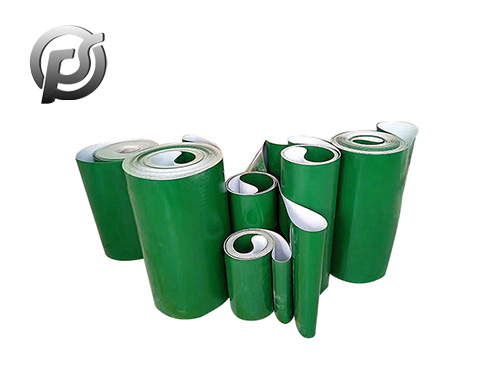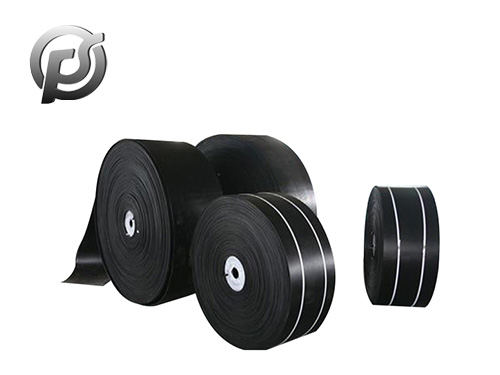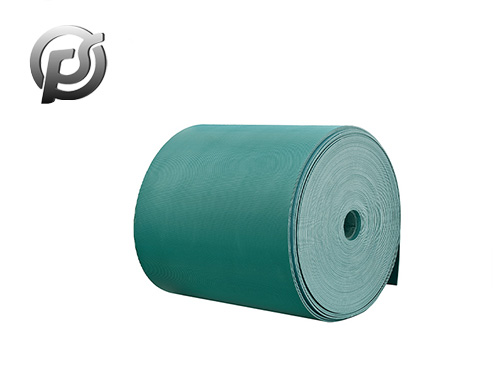The pattern
conveyor belt is an inclination conveyor belt composed of a patterned covering rubber on the working face and a flat covering rubber on the non-working face and a belt core.
Pattern conveyor belt Features:
(1) Core material: ordinary cotton canvas, polyester-cotton blended canvas, nylon, polyester, etc.
(2) Bandwidth: 300 ~ 800mm (can be customized according to customer needs, can reach the width of the equipment can be post-processing multiple models)
(3) high pattern: 5,10,15,20 mm note: the pattern shape can be designed according to user requirements.
(4) Features: suitable for the Angle of 0 ~ 40° material conveying, to prevent material sliding.
composition
The pattern conveyor belt is composed of two parts: base belt and pattern.
Common varieties
Due to the different conveying materials and conveying Angle size, the shape and height of the pattern are also different. Commonly used varieties are: herringbone, figure eight, fishbone, U-shaped, cylindrical, pitting and so on. Or according to user requirements design, suitable for less than 30 degrees inclination of powder, granular, and block material pattern conveyor belt.
Maintenance of decorative pattern conveyor belt
The pattern conveyor belt is in transportation and storage. Should be kept clean and avoid direct sunlight or snow and rain leaching leaching, prevent and acid, alkali, oil, organic solvents and other substances, and keep a distance of one meter from the heating device.
The storage temperature should be kept between 18-40°C and The relative humidity should be kept between 50-80%.
During storage, the conveyor belt shall be placed in a roll, not folded, and should be turned once a season during placement.
Conveyor belts of different types and specifications and layers should not be connected together, and their joints should be bonded.
The type, structure, specification and number of layers of the conveyor belt should be reasonably selected according to the use conditions.
The running speed of the conveyor belt should not be more than 2.5 m/s, and the low speed should be adopted as far as possible for the materials with large block size and large wear resistance and the fixed unloading device.
The relationship between the diameter of the transmission drum of the conveyor and the conveyor belt layer, the matching of the transmission drum and the drum to be changed, and the groove of the idler should be relatively selected according to the design regulations of the conveyor.
The feeding direction can be carried out in the running direction of the conveyor belt. In order to reduce the impact of material falling on the conveyor belt, chute should be adopted to reduce the material falling distance; Conveyor belt receiving section should shorten the distance between idlers and use buffer idlers for leakage, with a soft and moderate baffle plate, so as to avoid the baffle plate too hard, scratch the belt surface of the conveyor belt.
Precautions for conveyor belt use
With the popularization of conveyor belt in industrial production, multiple varieties, high performance, lightweight, multi-function and long life are the concerns of manufacturers. In industrial production, the correct use of conveyor belts is particularly important. The following items should be paid attention to when using conveyor belts:
1. Avoid rollers being covered by materials, resulting in inefficiency of rotation, and prevent material leakage stuck between the roller and the belt. Pay attention to the lubrication of the conveyor belt, but do not grease the conveyor belt;
2. Prevent the conveyor belt from starting to run under load;
3. Once the conveyor belt deviates, measures should be taken in time to correct the deviation of the conveyor belt;
4. When partial damage of conveyor belt is found, artificial cotton should be used to repair it in time to avoid expansion;
5. Avoid the block of the conveyor belt by the frame, pillar or block material to prevent the collision and tear.
 Optimizing Operations with PE Conveyor Belts: Durability, Efficiency, and Versatility
Optimizing Operations with PE Conveyor Belts: Durability, Efficiency, and Versatility
 Exploring the Efficiency and Versatility of Light Conveyor Belts
Exploring the Efficiency and Versatility of Light Conveyor Belts
 Polyester Conveyor Belts: Enhancing Efficiency and Reliability in Material Handling
Polyester Conveyor Belts: Enhancing Efficiency and Reliability in Material Handling